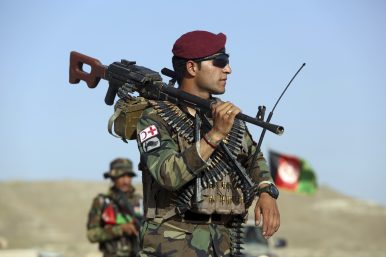By Muhammad Nawaz Khan
 In South Asia, a tussle is underway between Islamic State (ISIS) and like-minded groups, the Tehrik-i-Taliban Pakistan (TTP, which is currently based in Afghanistan), the Afghan Taliban, and al-Qaeda. The jihadi groups seek to establish one of two major competing Islamist political orders – the “Caliphate political order” or the “Amir-ul-Momineen political order.” Collectively, these groups have launched four different jihads with the goal of creating either “Islamic State Khorasan Province,” the “Islamic State of Khorasan,” or the “Islamic Emirate of Afghanistan or Waziristan.”
In South Asia, a tussle is underway between Islamic State (ISIS) and like-minded groups, the Tehrik-i-Taliban Pakistan (TTP, which is currently based in Afghanistan), the Afghan Taliban, and al-Qaeda. The jihadi groups seek to establish one of two major competing Islamist political orders – the “Caliphate political order” or the “Amir-ul-Momineen political order.” Collectively, these groups have launched four different jihads with the goal of creating either “Islamic State Khorasan Province,” the “Islamic State of Khorasan,” or the “Islamic Emirate of Afghanistan or Waziristan.”
Against the backdrop of these different jihads, it seems that ISIS is facing serious difficulties in establishing its Islamic State Khorasan Province (ISKP) in South Asia. Currently, an intense ideological rivalry is going on in Afghanistan between ISIS and like-minded groups and the Afghan Taliban along with bandwagoning groups. As a result, the ISIS Afghanistan chapter has not been able to achieve the level of success it saw initially in Iraq and Syria. If ISIS is not able to score successes in a weaker state like Afghanistan, then its future prospects for taking roots elsewhere in South Asia are likely limited. To understand any possible future prospects for ISIS in the region, there is a need to understand the political vision of ISIS, while comparing and contrasting it to those being advocated by al-Qaeda, the Afghan Taliban, and TTP.
In South Asia, ISIS aims to establish Khorasan Province under the Caliphate system because Abu Bakr al-Baghdadi, a self-proclaimed caliph, has declared all other “Sultanates,” “Amir-ul-Momineen,” and “Emirates,” including the Taliban’s movement, to be illegal. A map published by ISIS depicted areas for enlargement in the Middle East, the Muslim countries of Central and South Asia, North Africa, and mainland Spain. The map presents both Pakistan and Afghanistan as part of Khorasan province. ISIS considers the province as a campground for international jihad, from which the group would extend the Islamic State’s frontiers into other parts of the world, including India. The map, which depicted the territory that the group aimed to have under Islamic State’s domain in the next five years, was extensively distributed on social media.Enjoying this article? Click here to subscribe for full access. Just $5 a month.
Al-Qaeda seeks to establish its own Islamic State of Khorasan. It believes that the struggle for the creation of the Islamic State of Khorasan would arise from the Malakand area of Pakistan and Nuristan and Kunar provinces in Afghanistan. To fulfil its objective, on September 2014, Ayman al-Zawahiri proclaimed the establishment of Qaedat al-Jihad fi’shibhi al-qarrat al-Hindiya or al-Qaeda in the Indian Subcontinent (AQIS), also commonly known as al-Qaeda in South Asia. The creation of this new regional group, which followed soon after the formal split between al-Zawahiri and al-Baghdadi, was merely a reaction to the declaration of a caliphate system by the latter. Al-Qaeda did not release any map showing the area it envisioned to be the Islamic State of Khorasan. Although the group claims to remain allied and loyal to Afghan Taliban’s Amir-ul-Momineen, it has not given any statement indicating that the so-called Islamic State of Khorasan will be ruled by the latter.
Initially the above political vision was not part of TTP aims and objectives. Its declared aims are fighting against the Pakistani state, implementing Sharia (as interpreted by the TTP), and implementing a strategy against the U.S.-led NATO forces in Afghanistan. Later on it was reported that Baitullah Mehsud (killed August 2009) had wanted to establish the Islamic Emirate of Waziristan in the tribal areas of Pakistan; the present leader of the TTP, Fazlullah, is also influenced by the idea of the Khorasan movement and some consider him its founder. The TTP has given no statement that so-called Islamic Emirate of Waziristan will be ruled by the Afghan Taliban’s Amir-ul-Momineen. Rather, the TTP operates separately from the Afghan Taliban, though it is loosely aligned with the latter and claims to remain loyal to Amir-ul-Momineen. However, the TTP has explicitly rejected the ISIS Caliphate. According to the TTP, al-Baghdadi is not a caliph because in Islam, caliph means having command over the entire Muslim world. Al-Baghdadi only has command over a specific people and territory.
The Afghan Taliban has not only rejected the Islamic State’s political vision of establishing Khorasan Province under the Caliphate but is also actively fighting against ISIS in Afghanistan. The eventual goal of the Afghan Taliban is the resurgence “of the lost Islamic Emirate of Afghanistan.” As their focus is only on the political concept of this emirate, the Afghan Taliban’s jihad is confined to the territory of Afghanistan, with no regional or international ambition to establish any Islamic state (unlike ISIS and al-Qaeda). Due to its regional relevancy, the Afghan Taliban has proven more popular compared to ISIS in South Asia.
Muhammad Nawaz Khan is a researcher at the Islamabad Policy Research Institute. He writes on counter-radicalization.
No comments:
Post a Comment